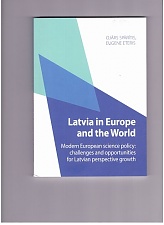Book review, Economics, Latvia
International Internet Magazine. Baltic States news & analytics
Wednesday, 02.07.2025, 04:14
Latvian science and research policy through a perspective vision
 Print version
Print version |
|---|
Significant changes have already occurred in approaches to
science and research policy (SRP) in the European states: main shifts on the
European science policy’s level are from research
and development (R&D) directions, which were dominant in the last
century into research, innovation and
investment (R&I) schemes to combine national and the EU scientific
potentials.
In order for the Baltic States’ research and innovation to
be successful in the years to come, these states need sufficient public support
and funding. National potentials are great in elaborating perspective visions
for Latvian innovative research.
These issues attracted the authors’ attention in a newly
published book in the Academy’s publication series “Latvia in Europe and the
world”. *)
*) Sparitis O. and Eteris E. Modern European science policy:
challenges and opportunities for Latvian perspective growth. Latvian Academy of Sciences’ publication
series: Latvia in Europe and the World, SIA Medicinas apgards publish. Riga, 2019. -214 pp. ISBN
978-9984-573-15-6
The book’s four parts describe the strategic guidelines for
Latvian growth is oriented towards an active role of science, research and
innovation. It’s true, combined and coordinated efforts among Latvian
decision-making institutions is generally needed in order for Latvia to gain
advanced positions in Europe and globally. It is in this direction that
contemporary debates about the role of
science and innovation in the national socio-economic development are going to
“promote” country’s necessary competitive advantages. And the book shows how
such debates can stimulate appearances of “future and emerging technologies”,
so-called FET, which represents challenging short- and long-term
research directions into uncharted science and technology areas.
The book’s first part
helps readers to understand the Latvian science-research policy’s role in
forming the European-type “scientific environment”, which consists of the
researchers’ efforts from all EU member states. As soon as the research,
innovation and technology are within both shared and supporting competences,
the Baltic States and Latvia are heavily relying on the EU’s financial
assistance: for example during last years, the EU institutions, together with
the member states have been considering financial perspective priorities for
the Union’s next seven years’ budget after 2020. These “perspectives” include,
among others, the existing Horizon 2020 program (the main EU’s research/innovation
programme up to 2020), as well as a new financial framework’s priorities aimed
at maximizing the impact of EU research and innovation in the member states
progressive development.
The book’s second part
is devoted to the researchers’ role in the Latvian “smart growth”, which is one
of the most important parts of the whole EU strategy’s message for the member
states. It is evident that the digital transformation in the Baltic States is
going to change the old-fashioned policy-making to benefit the more optimal and
efficient policy instruments. In this sense it is clear: by reducing
administrative costs (and workforce involved) associated with the public
sector, digitalisation can result in more effective policy’s settings as well
as increasing the digital component in corporate entities and governmental
structures.
Latvian government has to strengthen scientific and research
activities, though reject academic misconduct and refrain from needless and
“too-theoretic” research, in particular
with a limited national research budget (about one-third of the EU’s
requirement).
In this regard, the closer ties between the education and
research activities are needed, particularly in the universities, where the new
workforce is created; not only by the demand for enlarged up-skilling
(according to fast labour changes presently) but also with the more creative
approach in universities to supplement academic degrees with professional
qualifications.
The book’s third part
specifies Latvian strategies in “smart growth” and “national specialisation”
required by the EU-2020 strategy. It’s a new direction in Latvian perspective
growth, which is not going to be easy to implement, though science, research
and innovation activities can facilitate the process.
As soon as science and research activity in Latvia is
generally concentrated in universities, i.e. they are the domain of finding out
the most prospective and “special” spheres of Latvian growth. Presently with
the overwhelming intrusion of ICT and digital agenda into almost all spheres of
socio-economic development, these issues are becoming the focal points in the
Baltic States and Latvia which are greatly extending research and innovation
spheres in these countries.
However, it is still for the policy-makers to decide the
ways Latvia can achieve its vision of “inclusive innovation” and identify which
policy options are really aimed at achieving innovative growth.
The books fourth part
is devoted to the science policy’s role in perspective Latvian growth; major
Latvian socio-economic challenges are about maintaining the high level of
well-being. To reach this objective, structural reforms restoring
competitiveness, raising productivity and boosting employment will be
needed. The labour market needs to function better and work incentives
need to be further strengthened.
Science, technology and innovation are more than ever
crucial to boosting growth and jobs, and to addressing the great global and
European challenges: from socio-economic development, to climate change,
environmental quality and health. Therefore, support and sufficient financial
resources will be needed for research, innovation and education.
It is expected that the book will be received with interest
by the general public, education facilities and public authorities; the
authors’ main message to the latter is to maintain the willingness for
structural reforms, while keeping national economy constantly growing. In this
sense, Latvian society shall inspire the government’s efforts towards further
growth and wellbeing.
It has to be a political decision to support the Latvian
science and innovation policy; and it is decisive to know the most progressive
directions in this regard for our country. No doubt, the book is showing most
optimal perspectives for political choices.








 «The Baltic Course» Is Sold and Stays in Business!
«The Baltic Course» Is Sold and Stays in Business!

